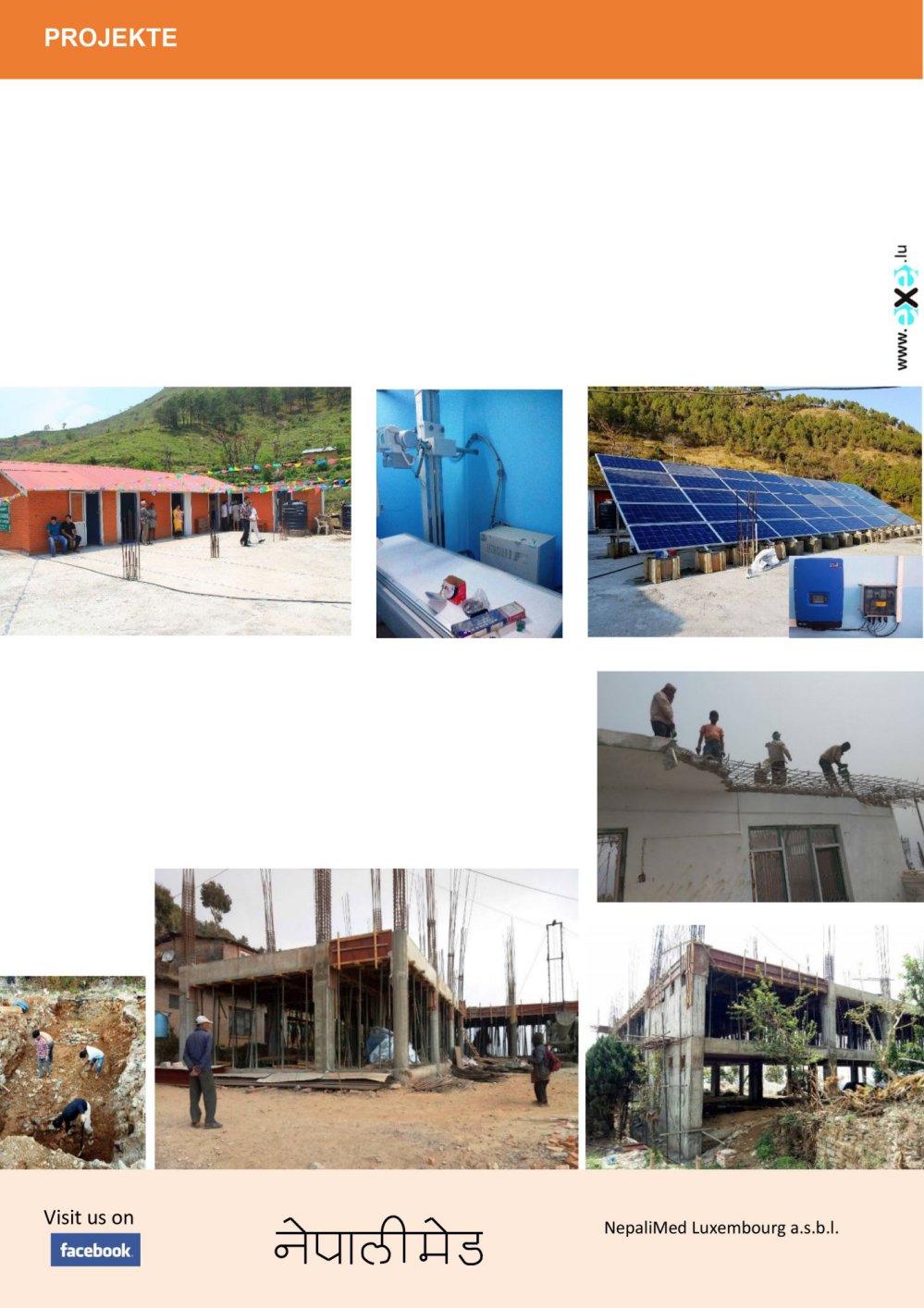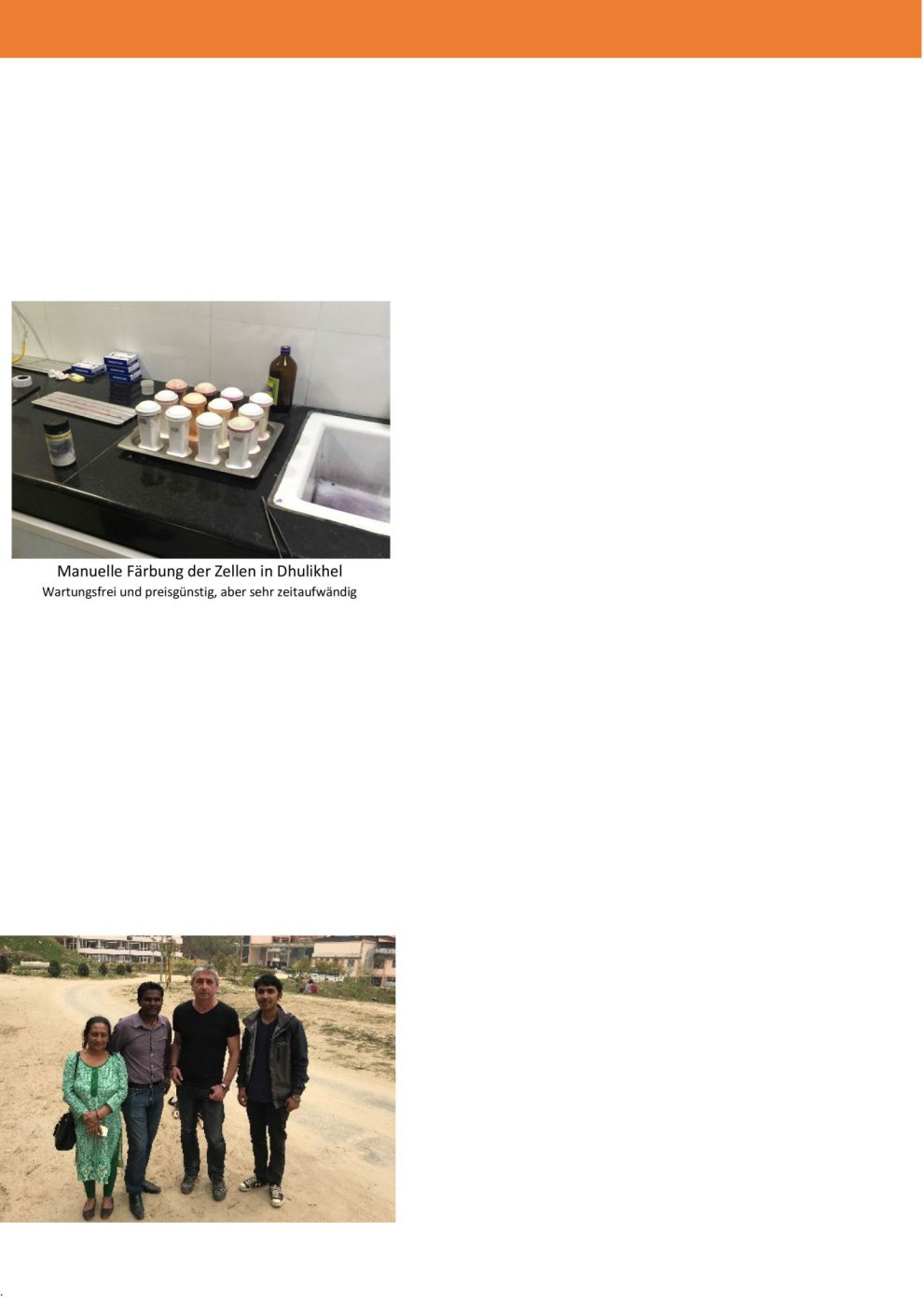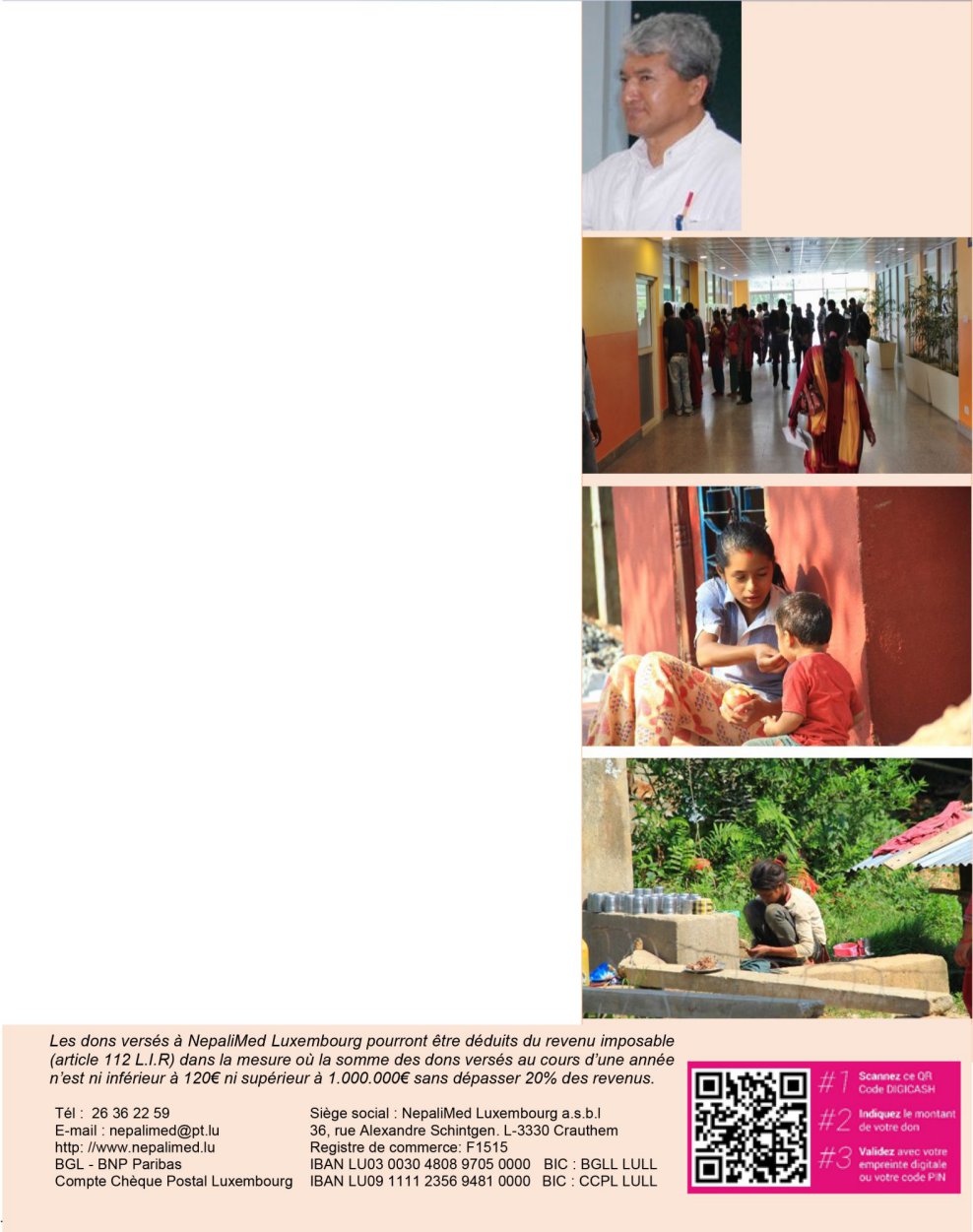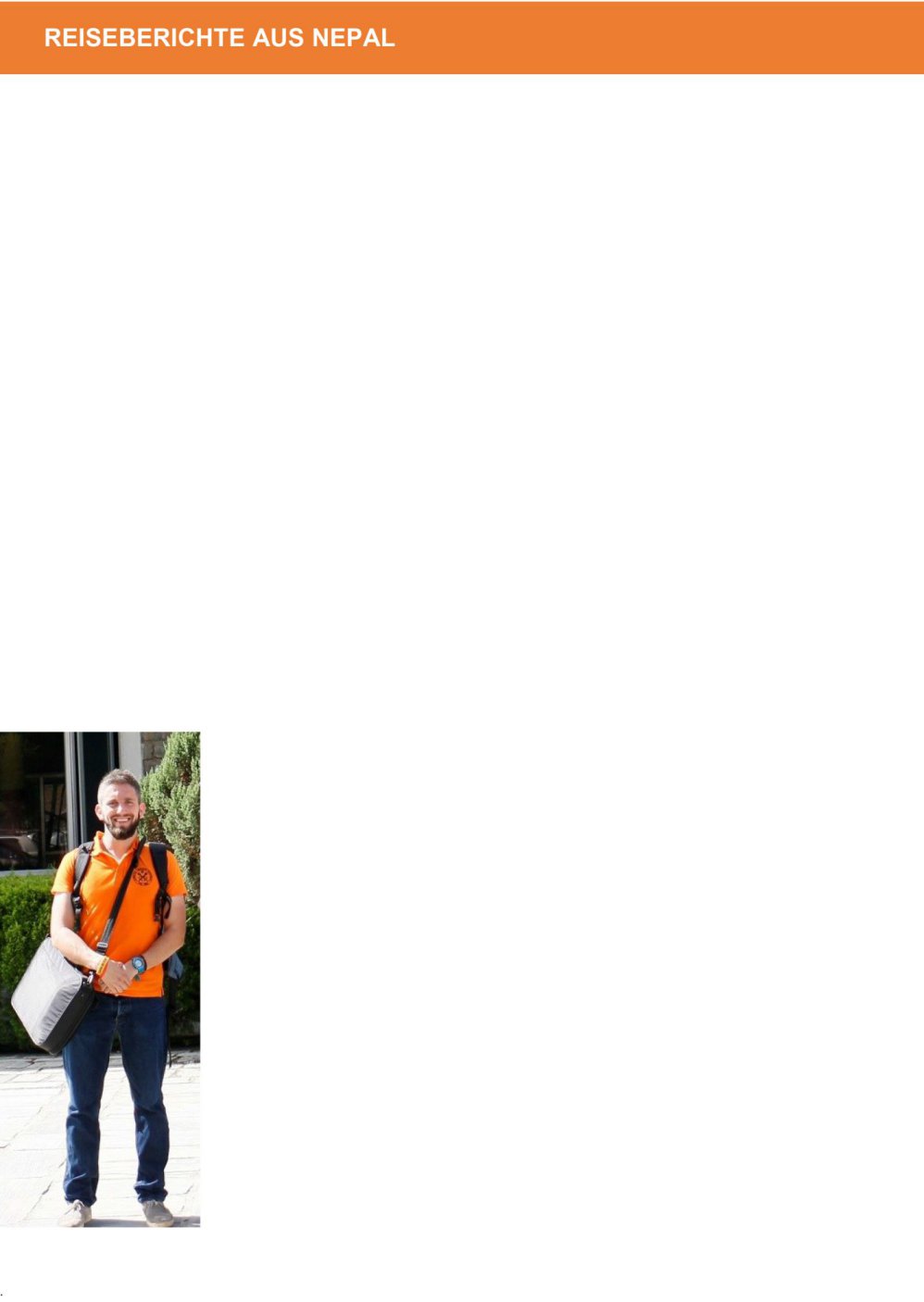-
-
Construction of Gaurishankar hospital
in Charikot in Dolakha district.
The old building damaged by the earthquakes was demolished, mostly by pickaxe and shovel, the still reusable material was recycled. Construction of the ground floor has been completed and the first floor is well under way. The deadlines are met, which is very surprising in Nepal.
Hardware purchase.
New government, new laws, instead of one, there are now six ministries that have to stamp import documents, so we are waiting with our partner for the arrival of medical equipment and devices.
Ordered in 2017 and pending delivery: Class 2A biological safety cabinet, "Minus 86 Freezer" freezer, real-time PCR, real-time PCR centrifuge, CO2 incubator, dry autoclave, fully automatized urine analyzer, stress tester, dishwasher.
Kattike-Deurali first aid station.
The second floor is finished and the radiology device is installed which posed a new problem: for lack of a voltage of 3x380 Volt and long and frequent power cuts, NepaliMed financed a solar energy installation.
PROJECTS
Manual staining of the cells in Dhulikhel.
Maintenance-free and inexpensive, but very time-consuming
Comment of Mr. Paul Kridel:
I have visited the hospital and have personally met Roshan.
What you have achieved is really impressive
Since the quality of the smears in Dhulikhel is often not ideal, pathologists would like to switch to the so-called liquid-based method (LBM) The liquid is then mechanically filtered in the laboratory and distributed on the microscope slide. The biggest advantage of this method is that the cells lie nicely side by side and do not overlap, as is often the case with the conventional method. This reduces the risk of misinterpretation. In addition, the area to be examined is much smaller, which saves an enormous amount of time. We successfully introduced this method at the LNS a few years ago. We have invited a pathologist from Dhulikhel to familiarize herself with the method at the LNS for 3 weeks.
Judging by the pungent smell, an extractor hood is painfully missed. Some cells are stained with toxic substances that pose a high risk to the health of employees. This must be remedied at all costs.
Afterwards Roshan and I took the clothes to the children's ward, which I remembered as quite lively, and the medication to the pharmacy. Afterwards Roshan showed me his office in the Community Department, where he takes care of the outreach centers. Strengthened with tasty Momos from the canteen, I was then driven to my hotel.
Since I am active in the early detection of cervical cancer at the LNS in Luxembourg, my greatest interest was of course in the Department of Pathology. There I was warmly welcomed by Dr Ramesh Makaju and his team. After a short chat, I was shown the premises.
While in Luxembourg the LNS examines cervical smears from all gynaecological practices nationwide, in Dhulikhel it is only those taken in the hospital itself, namely about 16,000 a year. Considering that the Dhulikhel Hospital covers a population of 1.9 million and the LNS one of 600,000, this is disproportionate. A solution would need to be found to enable more women to benefit from early cancer detection. A possibility would be a large-scale vaccination against papilloma virus, the main cause of cervical cancer. According to the WHO, there are between 30 and 45 new cases of cancer per 100,000 women per year in Nepal and less than 8 in
Luxembourg, where early diagnosis is essential in order to prevent cancer from developing in the first place.
Mrs Lauri Rollinger made a trip to Nepal, here is the report of the hospital visit in Dhulikhel.
Pathology at Dhulikhel Hospital.
On the last day of a guided tour through Nepal, we stopped in Dhulikhel. I did not miss the opportunity to visit the Dhulikhel Hospital. Loaded with two large bags of children's clothes, which I had brought from home and with medicines, which I had collected from our travel group, I left our bus in front of the entrance of the hospital area. There I met, as agreed, with Roshan Mahato, who was kind enough to guide me. I was really impressed by the size of the area and the number of buildings it feelt like a small village.
The hospital is self-financed mainly through university registration fees, with medical payments from wealthy patients coming from abroad and with the support of eleven non-governmental organizations, but chronic pathologies would greatly increase medical costs and I fear the hospital would have no choice but to turn to a strategy of privatization and collaboration with large pharmacological companies and others to survive.
In my presentations to future doctors, I have done my utmost to inform them of the Western medical situation and to beware of Western illusions not to copy the same mistakes. I also offered them some alternative solutions and prevention ideas, and of course, it was with passion that I told about my profession as an osteopath and the multidisciplinary approach. I was well aware that it is impossible for me to reach everyone, but I hope that I have been able to initiate some future prodigies who will partially follow my advice and who will find by themselves better alternative solutions to avoid the worst to the Nepalese.
I thank the whole Nepalimed team for giving me the opportunity to discover this beautiful country and to meet so many lovely people who have inspired me personally and professionally.
"We travel to change, not place, but ideas" - Hippolyte Taine.
.
Laurent Devalet
Excerpt from the report with the conclusions of the stay of Mr Laurent Devalet, Ostéopathe D.O.
You will find the full text on our website: www.nepalimed.lu
"He who is the master of himself is greater
than he who is the master of the world" - Buddha
With a vision of a multidisciplinary medicine in which the different professionals listen to each other, share their knowledge and collaborate serenely, I arrived in Nepal. I didn't really know what awaited me and what I was able to offer to the Nepalese, but at first I wanted above all to listen to them and learn to know them to avoid any hurtful clumsiness and to be build up a bad reputation. Despite the fact that I very much wanted to share my idealism, my knowledge of osteopathy and my osteopathic practice. It turned out to be a good idea for me to remain quite reserved and observant during my first days, because it was with the greatest pride that I was introduced to the Dhulikhel Hospital and I must admit that I was very surprised. I never expected to discover a modern hospital complex on a huge surface, including the latest generation medical equipment and instrumentation with a very well trained staff.
Dhulikhel Hospital indeed resembles Western hospital complexes with the same structure and the same internal organization, i.e. we have a "classic" hospital where patients register at the reception and are thus sent to the different specialization services according to their pathology or their suffering. Although the goal of creating "a modern hospital that meets Western standards" is clearly well accomplished, the Nepalese are not content with their current result and want to expand it further by building new centers, such as a 7-storey tower with dental, orthodontic and stomatological care. They wish to become the largest and most modern hospital center in the country and to expand in the form of a large network of small clinics throughout Nepal. Small clinics outside large cities, known as out-reached centers, aim to provide basic medical care to rural populations who live mainly in areas that are difficult to access by emergency services in the event of an accident, epidemic or natural disaster (floods, storms and earthquakes). However, during the last great earthquake in 2015, many of these small clinics were destroyed or badly damaged, and I was very pleased to learn that many charitable associations, such as Nepalimed and Actions pour un Monde Uni, are supporting the renovation or reconstruction of various clinics.
STORY TRAVEL IN NEPAL
Ladies and gentlemen, dear friends,
Some of you have known us and the hospital for a long time, some have already been to Nepal or heard about NepaliMed and the help we have received for many years but also about our progress together over the past 20 years.
Our warmest thanks go to NepaliMed Luxembourg, the tireless members of the Board of Directors and all those who support this cause.
That is why we look to the future with optimism and strength and thank you for accompanying us on our path and contributing to improving medical care for patients at Dhulikhel Hospital and our outpatient stations.
Namaste warm and best wishes, stay healthy.
Your Ram Shrestha
Dear friends, dear friends of Nepal,
These few words from our friend and founder of the Dhulikhel Hospital are very encouraging and motivate us further to continue our support for the people of this small Himalayan country.
On the following pages you will find some impressions of people who have visited and worked at the hospital as well as the report of our projects.
I wish you a good reading. My thanks for your help and I hope I can count on you to continue our work.
Best regards and a warm Namaste,
(s) Marie Anne Carier
june 2018




